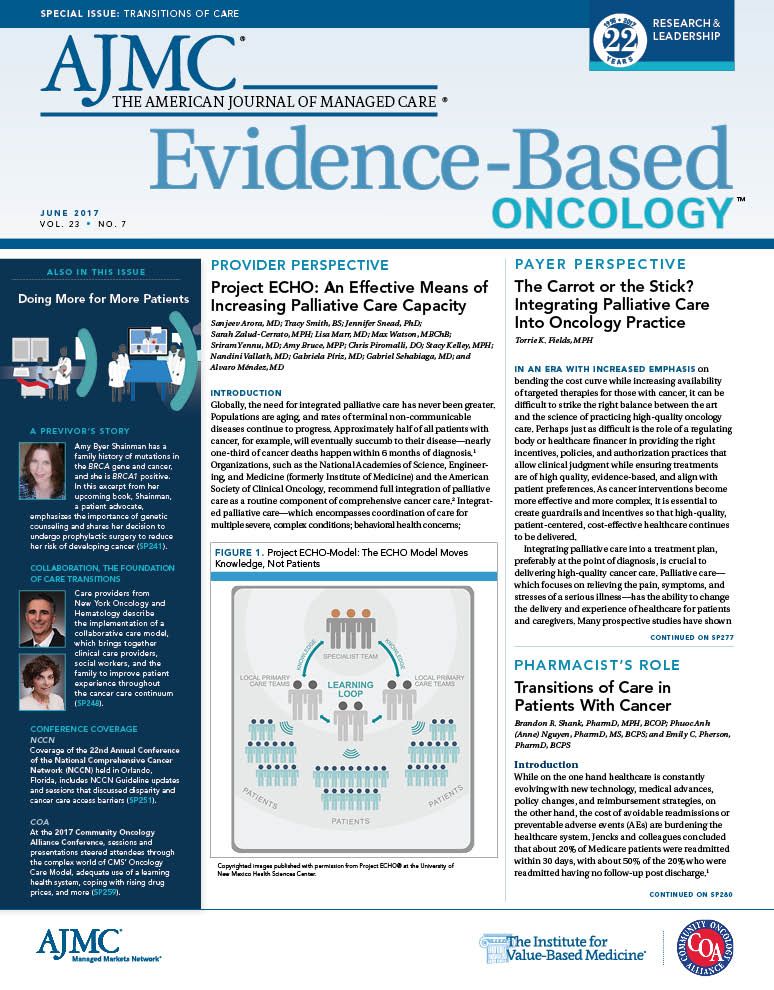Publication
Article
Evidence-Based Oncology
The Transition to Integrate Palliation in Cancer Care
Author(s):
High-quality cancer care can only occur when the “transitions in care” are delivered in a prospectively planning, systematic, patient-centered way.
The nature of a cancer diagnosis and subsequent treatment is that patients are not only faced with the challenges of undergoing complex, often intensive, treatments, but also with the many changes in their care setting, providers, ancillary services, and goals of care that may occur over the course of their cancer journey. Unlike diseases like community-acquired pneumonia, in which care is limited to a discreet episode, the longitudinal nature of care needs for patients with cancer requires a different, more comprehensive system of care delivery. This, by necessity, requires that our system deliver care throughout the numerous transitions that our patients experience. High-quality cancer care can only occur when these “transitions in care” are delivered in a prospectively planning, systematic, patient-centered way. There are diverse arrays of transitions of care that mark the cancer care experience: inpatient to outpatient care, pediatric to adult care, therapy with curative intent evolving toward therapy directed towards palliation.
Throughout these transitions of care the stakes for the patient are very high; we have both an opportunity to contribute substantively to the patient-centeredness of care or to undermine the delivery of effective care. In this issue of Evidence-Based Oncology™ (EBO™), we attempt to illustrate some of these episodes of care and highlight the opportunities for improving the effectiveness of care through these transitions.
One example of an immensely important transition of care for patients is that of ensuring the early integration of palliative/supportive care into post-cancer diagnosis treatment planning. However, the early use of palliative care is often a missed opportunity. There is a common misperception that palliative care solutions are only germane to patients at the end-of-life, thus initiation of these services are often delayed until patients are referred for hospice or comfort care services.1 Cancer patients have an extraordinary number of care needs that are frequently under recognized and therefore unaddressed within our current care delivery system.
The World Health Organization defines palliative care as:
An approach that improves the quality of life of patients and their families facing the problem associated with life-threatening illness, through the prevention and relief of suffering by means of early identification and impeccable assessment and treatment of pain and other problems, physical, psychosocial and spiritual.2
Given the breadth of clinical skills that palliative care physicians can bring to the patient, this set of care services has the ability to complement the skills of the medical oncologist/hematologist in serving unmet patient care needs through treatment and survivorship.
The unique expertise of palliative care physicians can, in fact, help us bring increasingly more patient-centeredness to our care delivery system. In a study comparing the impact of an early versus delayed model of palliative care referral for patients with non—small-cell lung cancer, there was no difference in the total number of chemotherapeutic regimens used per patient in either group, but there was a significant improvement for the early consultation group in the use of chemotherapy in the last 60 days of life, a longer interval between the last chemotherapy regimen and death, and a higher proportion of patients who survived for more than 1 week under hospice care.3
Palliative care represents only one of the many opportunities for mindful, value-added care transitions that can enhance the lives of our patients. The idea of carefully aligning expertise and clinical skills, delivered through carefully orchestrated transitions of care, represent a major advance in cancer care. In this issue of EBO™, we explore a number of these key opportunities to improve the experience of patients affected by cancer. Sanjeev Arora, MD, and colleagues review the ECHO model of palliative care that brings together primary care physicians and expert specialists for transition- of-care mentoring and communication of best practices. Brandon R. Shank, Phuoc Anh Nguyen, and Emily C. Pherson provide an overview of the role that pharmacists may serve in enhancing the effectiveness of transitions of care for cancer patients in ways that improve medication safety. Amy Byer Shainman shares her experience as a cancer “previvor” in navigating transitions in care for patients who are at high-risk of eventually developing cancer. Finally, Rufus Collea, MD, and colleagues provide their perspective on innovative strategies that can be used to improve palliative care, patient navigation, and interdisciplinary patient-family communication.
How can we ensure that more patients can benefit from effective, early palliative care? Perhaps this involves the breadth of stakeholders who participate in the care of these patients to overcome their prejudices over the word “palliative.” Palliation involves an acknowledgement that a patient’s cancer care needs extend well beyond the need for surgery, chemotherapy, and radiation therapy. In embracing the full range of needs of our patients, including the need to manage the distress associated with a cancer diagnosis, we can continue to bring increasingly effective, patient-centered care to those in need. A partnership between the oncologist and the palliative care physician provides an increasingly robust response to the needs of our patients and their families. AUTHOR INFORMATION
Joseph Alvarnas, MD, is director of value-based analytics and clinical associate professor, Department of Hematology/Hematopoietic Cell Transplantation, City of Hope, Duarte, CA. He is also the editor-in-chief of Evidence-Based Oncology™.REFERENCES
- Berry LL, Castellani R, Stuart B. The branding of palliative care. J Oncol Pract. 2016;12(1):48-50. doi: 10.1200/JOP.2015.008656.
- WHO definition of palliative care. World Health Organization website. http://www.who.int/cancer/palliative/definition/en/. Accessed May 23, 2017.
- Greer JA, Pirl WF, Jackson VA, et al. Effect of early palliative care on chemotherapy use and end-of-life care in patients with metastatic non—small-cell lung cancer. J Clin Oncol. 2012;30(4):394-400. doi: 10.1200/JCO.2011.35.7996.





